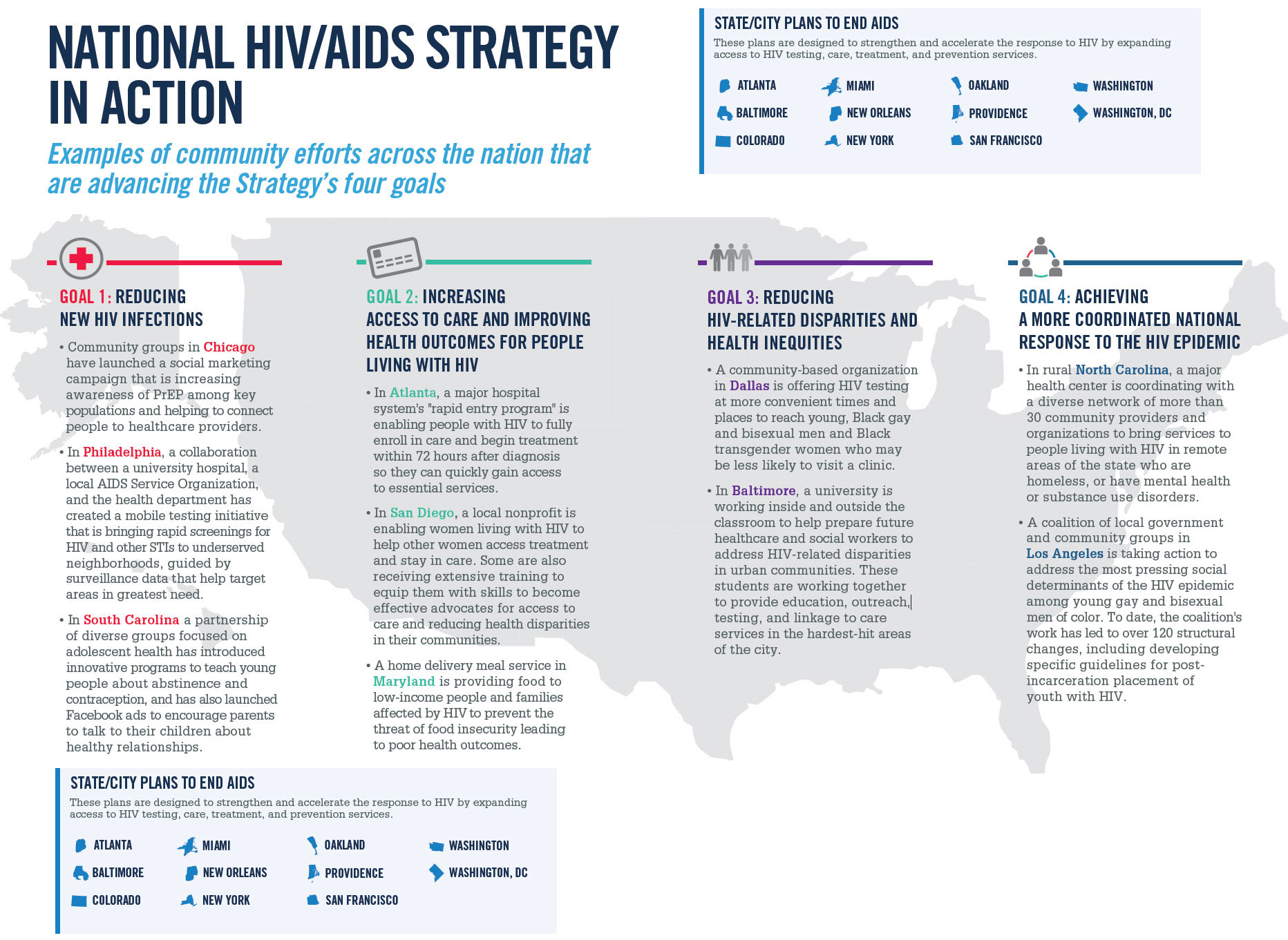Overview
National HIV/AIDS Strategy 2016 Progress Report
In December 2016, the White House released the 2016 Progress Report on National HIV/AIDS Strategy implementation. The Strategy, our comprehensive plan to reduce new HIV infection, improve health outcomes, reduce disparities, and achieve a more coordinated national response, was updated in 2015 to serve as our country’s roadmap toward 2020.
Read the 2016 Progress Report on National HIV/AIDS Strategy Implementation. (PDF 788 KB)
View an infographic on major milestones (PDF 52.9 KB) between 2010 and 2016.
Community Voices Discuss the Strategy
People living with and affected by HIV discuss the release of the National HIV/AIDS Strategy: Updated to 2020 and its importance to the HIV community.
What is the National HIV/AIDS Strategy?
The National HIV/AIDS Strategy is a five-year plan that details principles, priorities, and actions to guide our collective national response to the HIV epidemic.
First released on July 13, 2010, the Strategy identified a set of priorities and strategic action steps tied to measurable outcomes for moving the Nation forward in addressing the domestic HIV epidemic. In July 2015, the National HIV/AIDS Strategy for the United States: Updated to 2020 was released. The updated Strategy reflects the work accomplished and the new scientific developments since 2010 and charts a course for collective action across the Federal government and all sectors of society to move us close to the Strategy’s vision.
Strategy Vision
The United States will become a place where new HIV infections are rare and when they do occur, every person regardless of age, gender, race/ethnicity, sexual orientation, gender identity or socio-economic circumstance, will have unfettered access to high quality, life-extending care, free from stigma and discrimination.
Strategy Goals
- Reduce New Infections
- Increase Access to Care and Improve Health Outcomes for People Living with HIV
- Reduce HIV-Related Health Disparities and Health Inequities
- Achieve a More Coordinated National Response to the HIV Epidemic
Indicators of Progress
The following indicators of progress are identified in the National HIV/AIDS Strategy: Updated to 2020:
Indicator 1
Increase the percentage of people living with HIV who know their serostatus to at least 90 percent.
Indicator 2
Reduce the number of new diagnoses by at least 25 percent.
Indicator 3
Reduce the percentage of young gay and bisexual men who have engaged in HIV-risk behaviors by at least 10 percent.
Indicator 4
Increase the percentage of newly diagnosed persons linked to HIV medical care within one month of their HIV diagnosis to at least 85 percent.
Indicator 5
Increase the percentage of persons with diagnosed HIV infection who are retained in HIV medical care to at least 90 percent.
Indicator 6
Increase the percentage of persons with diagnosed HIV infection who are virally suppressed to at least 80 percent.
Indicator 7
Reduce the percentage of persons in HIV medical care who are homeless to no more than 5 percent.
Indicator 8
Reduce the death rate among persons with diagnosed HIV infection by at least 33 percent.
Indicator 9
Reduce disparities in the rate of new diagnoses by at least 15 percent in the following groups: gay and bisexual men, young Black gay and bisexual men, Black females, and persons living in the Southern United States.
Indicator 10
Increase the percentage of youth and persons who inject drugs with diagnosed HIV infection who are virally suppressed to at least 80 percent.
In addition, three Developmental Indicators were announced in December 2016 to better monitor progress towards the goals of the Strategy:
Indicator 11 (Developmental)
Increase the percentage of transgender women in HIV medical care who are virally suppressed to at least 90 percent.
Indicator 12 (Developmental)
Increase the number of adults prescribed PrEP by at least 200 percent.
Indicator 13 (Developmental)
Decrease stigma among persons with diagnosed HIV infection by at least 25 percent.


